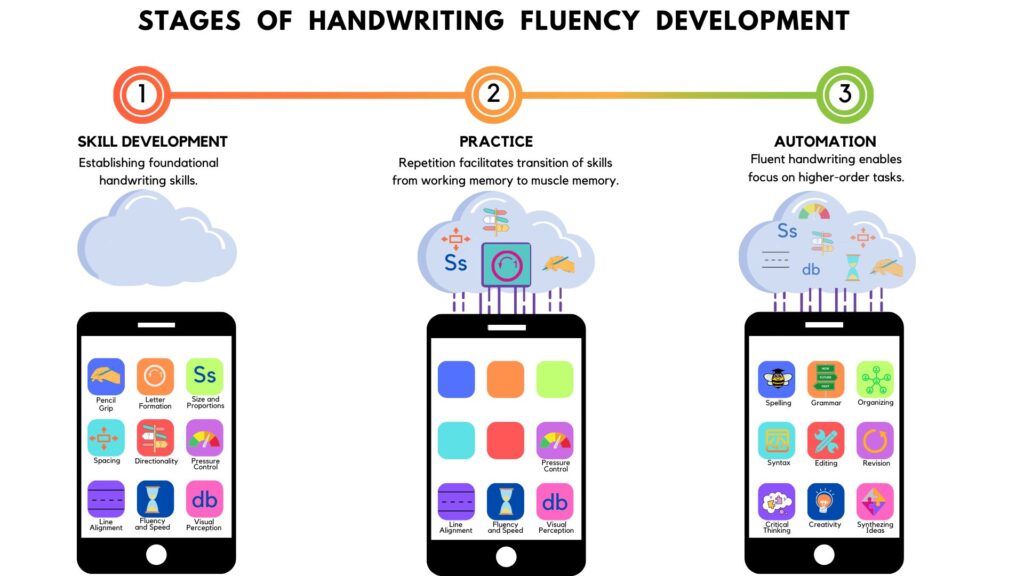In a busy first-grade classroom, Sam diligently completed his worksheet, meticulously crafting each letter. However, his letter formation displayed a noticeable inconsistency, sometimes starting from the bottom and other times from the top. His writing pace also lagged behind his peers.
As the school year progressed, Sam’s classmates continued to refine their handwriting skills, effortlessly translating their thoughts onto paper. Meanwhile, Sam’s struggle with the mechanics of writing persisted. Forming letters still monopolized most of his attention, leaving minimal room for creativity and self-expression.
Examining Sam’s situation using Load theory, a psychological concept that provides insights into information processing, highlights the critical role of working memory. Working memory functions as a short-term mental workspace where individuals actively process and manipulate information for brief periods. It’s essential to understand that working memory has limitations in terms of capacity and duration, which can lead to overload when excessive cognitive demands are placed on it.
In Sam’s case, his ongoing struggle to master basic handwriting skills, such as letter formation and word spacing, dominates his working memory. Consequently, he has limited mental resources available for more advanced writing tasks, such as generating ideas, ensuring accurate spelling, and constructing sentences, leading to difficulties in these areas.
To illustrate, consider Sam’s working memory as a smartphone—it can handle only a limited amount of information at once. With numerous apps open to address basic handwriting mechanics, there’s little bandwidth left for higher-level thinking tasks.
We can identify three stages of Handwriting Fluency Development:

Stage 1: Skill Development
During the initial stages of handwriting instruction, a significant portion of working memory is dedicated to managing the mechanics of handwriting, much like when a phone’s resources are consumed by resource-intensive applications. Learning handwriting initially places a substantial cognitive load on individuals. It involves complex tasks, such as forming letters, perfecting pencil grip, coordinating hand movements, and ensuring proper letter size, spacing, and alignment.
These tasks require the acquisition of new and unfamiliar motor coordination and visual perception skills, highlighting the necessity of guidance from a teacher. Without proper instruction, students may develop irregular and inefficient letter-writing techniques. Unfortunately, when students lack supervision, progressing to the next stage of fluency development becomes exceptionally challenging, as was the case for Sam.
To help students acquire these skills, we take an explicit approach. Letter formation is broken down into clear, step-by-step instructions and taught systematically. This method allows students to learn the precise movements needed to create each letter, encompassing an understanding of the shape, size, and sequence of strokes for each letter.
Stage 2: Practice - Building Muscle Memory
With consistent, precise practice, the various tasks involved in handwriting transition from occupying working memory to becoming stored in muscle memory. Muscle memory acts as a long-term memory system responsible for retaining information related to physical tasks. The more students practice, the stronger the neural pathways associated with handwriting become, requiring less conscious effort.
In the smartphone analogy, as each skill becomes more reflexive, they move from the smartphone to the cloud. This way, they can be easily accessed without draining the phone’s processing power.
Stage 3: Automation
Fluency, defined as the capacity to write quickly and accurately with minimal effort, lies at the core of effective writing. Once handwriting becomes automatic, the cognitive load associated with it decreases significantly. This frees up working memory for higher-level writing tasks. Think of it as making space for new applications that allow you to focus on:
- Expressing ideas and creativity
- Improving spelling and grammar
- Writing faster and more efficiently.
To nurture student’s competence as a writers, they must advance through these stages, shifting their foundational skills from consuming their working memory to becoming automated. Recognizing this progression is crucial, emphasizing the importance of structured handwriting instruction. Ultimately, by relieving the cognitive load of basic tasks and creating room for higher-order thinking, we not only elevate their writing abilities but also establish a robust foundation for lifelong literacy, ensuring that no student’s potential remains constrained by the challenges of mechanical handwriting.

